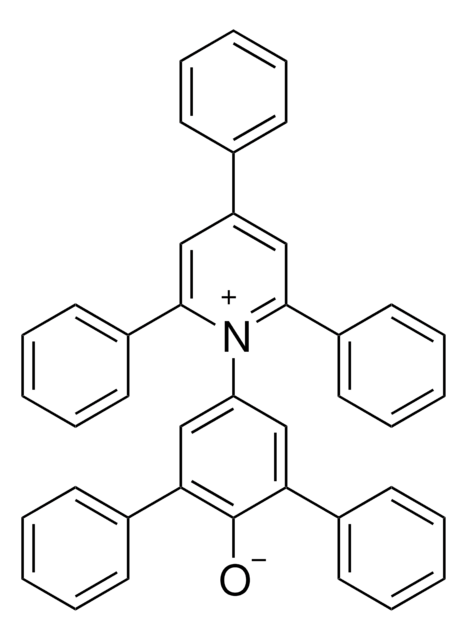Dye solar cells degrade from ultraviolet radiation. For this reason, the barrier may include UV stabilizers and/or UV absorbing luminescent chromophores (which emit at longer wavelengths) and antioxidants to protect and improve the effieciency of the cell.
703168
cis-Bis(isothiocyanato)(2,2′-bipyridyl-4,4′-dicarboxylato)(4,4′-di-nonyl-2′-bipyridyl)ruthenium(II)
95% (NMR)
Sinonimo/i:
Greatcell Solar®, Z-907 dye
Scegli un formato
Scegli un formato
About This Item
Prodotti consigliati
Livello qualitativo
Saggio
95% (NMR)
Stato
powder
Composizione
Dye content, ≥90%
Punto di fusione
196 °C
λmax
531, 314, 295 nm (lit.)
Stringa SMILE
S=C=N[Ru]N=C=S.OC(=O)c1ccnc(c1)-c2cc(ccn2)C(O)=O.CCCCCCCCCc3ccnc(c3)-c4cc(CCCCCCCCC)ccn4
InChI
1S/C28H44N2.C12H8N2O4.2CNS.Ru/c1-3-5-7-9-11-13-15-17-25-19-21-29-27(23-25)28-24-26(20-22-30-28)18-16-14-12-10-8-6-4-2;15-11(16)7-1-3-13-9(5-7)10-6-8(12(17)18)2-4-14-10;2*2-1-3;/h19-24H,3-18H2,1-2H3;1-6H,(H,15,16)(H,17,18);;;/q;;2*-1;+2
LALSZYPVVQFXIC-UHFFFAOYSA-N
Categorie correlate
Applicazioni
Note legali
Greatcell Solar is a registered trademark of Greatcell Solar Materials Pty Ltd.
Avvertenze
Warning
Indicazioni di pericolo
Consigli di prudenza
Classi di pericolo
Eye Irrit. 2 - Skin Irrit. 2 - Skin Sens. 1 - STOT SE 3
Organi bersaglio
Respiratory system
Codice della classe di stoccaggio
11 - Combustible Solids
Classe di pericolosità dell'acqua (WGK)
WGK 3
Punto d’infiammabilità (°F)
Not applicable
Punto d’infiammabilità (°C)
Not applicable
Dispositivi di protezione individuale
dust mask type N95 (US), Eyeshields, Faceshields, Gloves
Scegli una delle versioni più recenti:
Possiedi già questo prodotto?
I documenti relativi ai prodotti acquistati recentemente sono disponibili nell’Archivio dei documenti.
I clienti hanno visto anche
Articoli
Dye-sensitized solar cells directly convert sunlight to electricity
Operation principle and market dominance of single crystalline silicon solar cells.
Organic materials in optoelectronic devices like LEDs and solar cells are of significant academic and commercial interest.
Dye-sensitized solar cells (DSCs) are 3rd generation solar cells combining the promise of high efficiency with low production costs.
-
What can cause degradation of the dye solar cell?
1 risposta-
Utile?
-
-
What is the Department of Transportation shipping information for this product?
1 risposta-
Transportation information can be found in Section 14 of the product's (M)SDS.To access the shipping information for this material, use the link on the product detail page for the product.
Utile?
-
-
What are the advantages of dye solar cells?
1 risposta-
Dye solar cells (DSCs) are 3rd generation solar cells with the promise of high efficiency combined with low production costs.
Utile?
-
-
What are the disadvantages of dye solar cells?
1 risposta-
The major disadvantage to the dye solar cell design is the use of a liquid electrolyte, which has temperature stability issues. The electrolyte can freeze at low temperatures and expand at higher temperatures. It the electrolytes freezes, power production would cease, and it could potentially lead to physical damage. If the liquid expands at higher temperatures, sealing the panels would be difficult.
Utile?
-
Filtri attivi
Il team dei nostri ricercatori vanta grande esperienza in tutte le aree della ricerca quali Life Science, scienza dei materiali, sintesi chimica, cromatografia, discipline analitiche, ecc..
Contatta l'Assistenza Tecnica.





2 ≥95%](/deepweb/assets/sigmaaldrich/product/structures/190/371/c5efe61d-383f-4364-90c6-1912d88674f3/640/c5efe61d-383f-4364-90c6-1912d88674f3.png)









